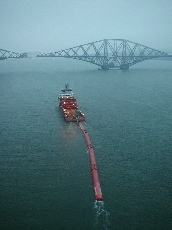New meaning to the term 'catch a wave'

OK, so not all of you are convinced that water is a worthwhile data center cooling system. Yes, I read your comments. And I love inspiring debate. So, mission accomplished as far as I'm concerned.
OK, so, indulge my water fetish a little more, will you?
How about the power of the ocean as a powerful source of renewable power?
That’s the business proposition behind Pelamis Wave Power (formerly known as Ocean Power Delivery) in Edinburgh, Scotland, which is harnessing wave energy for a bunch of experiments in Europe. (The Scottish government has apparently set out to generate about 18 percent of its electricity through renewable sources in three years. Its goal by 2020 is 40 percent.) The company has been around for almost 10 years doing experiments in the United Kingdom and Portugal, among other places.
At the heart of their R and D is something called the Pelamis.
The word actually means sea snake and it sure looks like one, consisting of cylinders that contain hydraulic pumps and motors. Think of a submarine that is sitting on the surface that is composed of individual sections, like a train. As the waves move the sections, it drives the motors, which in turn generate electricity that is pumped ashore. Here's an interactive model for you to explore.
Best to show this thing in action. Notice, this video not advised for those prone to motion sickness!
Pelamis aka Ocean Power is pretty far along on a project in Portugal and has some work going on now outside Cornwall as part of a project called WestWave.
You could imagine what some of the risks might be to this work. What if a major storm kicks up ala "The Perfect Storm?" Would that be good or bad for the Pelamis equipment? A storm clearly promises to produce more power, but will it wreck the machinery? What if the ocean is unusually calm? Will shipping traffic pose a risk to the devices? What parts of the world really have the wave power to be promising?
The bad news in my opinion is that the U.S. doesn’t have a whole lot of presence yet in this field, at least based on Google-able information. There’s some work going on in the Northwest, spearheaded by Finavera Renewables of Vancouver, B.C., which just announced the successful deployment of an AquaBuoy converter off Newport, Ore. Oceanlinx of Australia also has some projects going on in Oregon. And I am happy to say that Ocean Power Technologies, a company from my own home state, New Jersey, is also experimenting in the Pacific Northwest and Spain.
Aside from the Pelamis Wave Power Web site, here are some other Web resources:
